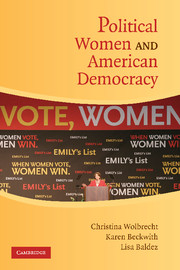Book contents
- Frontmatter
- Contents
- Preface
- List of Contributors
- Political Women and American Democracy
- 1 Introduction: What We Saw at the Revolution: Women in American Politics and Political Science
- 2 Gender as a Category of Analysis in American Political Development
- 3 Gender, Public Opinion, and Political Reasoning
- 4 Gender in the Aggregate, Gender in the Individual, Gender and Political Action
- 5 What Revolution? Incorporating Intersectionality in Women and Politics
- 6 Women's Movements and Women in Movements: Influencing American Democracy from the “Outside”?
- 7 Representation by Gender and Parties
- 8 Women as Candidates in American Politics: The Continuing Impact of Sex and Gender
- 9 Women as Officeholders: Linking Descriptive and Substantive Representation
- 10 Theorizing Women's Representation in the United States
- 11 Political Women in Comparative Democracies: A Primer for Americanists
- 12 Conclusion: Between Participation and Representation: Political Women and Democracy in the United States
- References
- Index
11 - Political Women in Comparative Democracies: A Primer for Americanists
Published online by Cambridge University Press: 05 September 2012
- Frontmatter
- Contents
- Preface
- List of Contributors
- Political Women and American Democracy
- 1 Introduction: What We Saw at the Revolution: Women in American Politics and Political Science
- 2 Gender as a Category of Analysis in American Political Development
- 3 Gender, Public Opinion, and Political Reasoning
- 4 Gender in the Aggregate, Gender in the Individual, Gender and Political Action
- 5 What Revolution? Incorporating Intersectionality in Women and Politics
- 6 Women's Movements and Women in Movements: Influencing American Democracy from the “Outside”?
- 7 Representation by Gender and Parties
- 8 Women as Candidates in American Politics: The Continuing Impact of Sex and Gender
- 9 Women as Officeholders: Linking Descriptive and Substantive Representation
- 10 Theorizing Women's Representation in the United States
- 11 Political Women in Comparative Democracies: A Primer for Americanists
- 12 Conclusion: Between Participation and Representation: Political Women and Democracy in the United States
- References
- Index
Summary
The United States is often heralded as an exemplary model of democracy, and this vision prompts many to assume that women in the United States enjoy greater equality than women anywhere else. As Gretchen Ritter (this volume) notes, “As the world's first modern democracy, one might expect that the United States has led the way in granting equal rights to women.” Women in the United States have come a long way, but we still have far to go before men and women gain political equality, as many of the chapters in this volume make clear. How does the United States compare with other countries in this regard? Any remaining expectation that the United States leads the world in terms of women's rights evaporates when you look at the United States in terms of the indicators now used to compare the status of women worldwide. Consider the percentage of women in elective office. The number of women elected to the U.S. House of Representatives has registered steady gains over time and, as of this writing, stands at 17.1 percent. In terms of the worldwide ranking of women in the lower houses of parliament, however, the United States stands in sixty-eighth place, between Zimbabwe and Turkmenistan. Because of ties among nations, the United States is actually eighty-first in the ranking; eighty nations have better records of electing women to national legislatures (Inter-Parliamentary Union 2007).
- Type
- Chapter
- Information
- Political Women and American Democracy , pp. 167 - 180Publisher: Cambridge University PressPrint publication year: 2008
- 1
- Cited by

